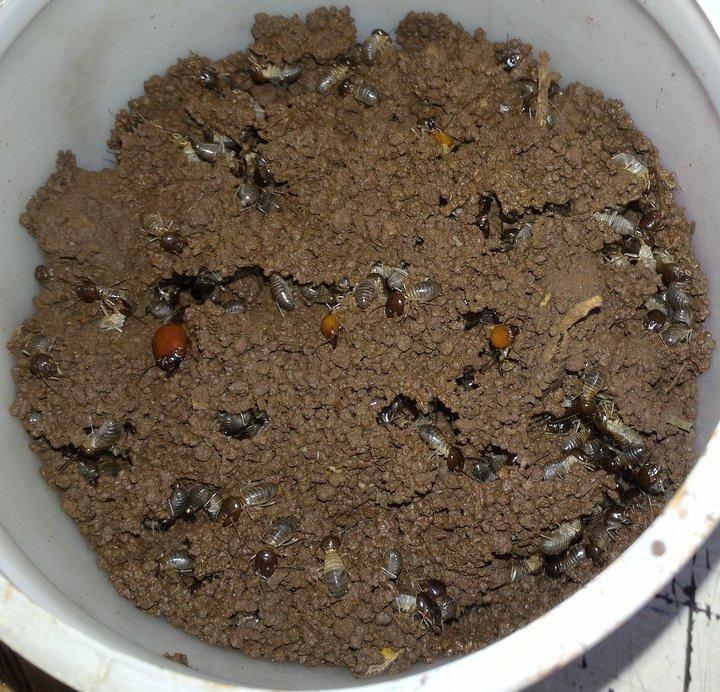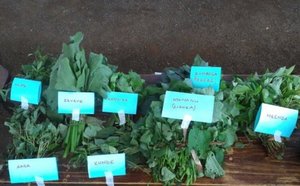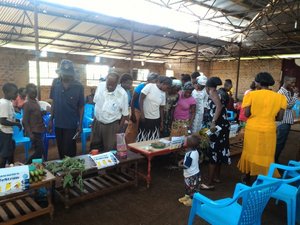Why community action to improve nutrition in Kenya includes a side order of termites

Julia Boedecker, Associate Scientist, Bioversity International, writes her latest blog from Vihiga County, Kenya, about our ongoing research to empower communities there to better use available agricultural biodiversity to improve nutrition all year round.
Julia Boedecker, Associate Scientist, Bioversity International, writes her latest blog from Vihiga County, Kenya, about our ongoing research there to empower communities to better use available agricultural biodiversity to improve nutrition all year round.
In this report, Julia describes a series of events organized by the communities to start the interventions that aim to improve their nutrition. These events included everyone bringing along their diverse local food dishes, including a dish of living termites (pictured left) which are a great source of animal protein.
Rural populations in developing countries often face food insecurity and malnutrition despite being often surrounded by extraordinary biodiversity. Also Vihiga County is rich in local food biodiversity. However, the diets of women and small children in the region are not diverse enough. Chronic malnutrition (stunting) affects 28% of the children. We are also seeing different forms of malnutrition in the caregivers – 8% are underweight while 18% are overweight with 7% classed as obese. This project will help to make better use of Vihiga’s agricultural potential in order to improve people’s diets.
The previous blog (see part 2 of the Vihiga reports below) reported on the participatory development of agricultural interventions. For two months, six community workshops were carried out in five sub-locations of Vihiga County. In each sub-location about 34 people took part (170 workshop participants in total). The workshops encouraged the participants to develop their own strategies to diversify diets in their community by using local food biodiversity. Most of the groups have chosen planting of vegetables and/or planting of legumes and poultry-keeping. Community action plans were developed that specified how exactly the interventions are to be realized.
Moving towards the implementation phase, Bioversity International wants to ensure that action goes beyond the 170 initial workshop participants and reaches the whole community. Therefore, we organized community events to officially kick-off the intervention phase and help spread the word.
 The Masana workshop group has been one of the most creative in teaching the wider community about what they have learned during the workshops. Besides presenting a song and poems, the workshop participants gathered all types of local foods and distributed them on tables according to the different food groups they were taught about in the workshops. These included up to 8 kinds of green leafy vegetables, most of them indigenous types like cowpea leaves (“kunde”), black nightshade (“managu”), spiderplant (“saga”), jute (“mrenda”) and pumpkin leaves (“severe”).
The Masana workshop group has been one of the most creative in teaching the wider community about what they have learned during the workshops. Besides presenting a song and poems, the workshop participants gathered all types of local foods and distributed them on tables according to the different food groups they were taught about in the workshops. These included up to 8 kinds of green leafy vegetables, most of them indigenous types like cowpea leaves (“kunde”), black nightshade (“managu”), spiderplant (“saga”), jute (“mrenda”) and pumpkin leaves (“severe”).
These well-known vegetables that have been considered as 'food for the poor' earlier, have gained popularity in Western Kenya within the last years. Reasons for this include campaigns by the Ministry of Health and NGOs to promote the nutritional value of indigenous leafy vegetables which are rich in many micro-nutrients and can be crucial for the food and nutrition security of poor families.
 The workshop participants did not hesitate to bring living objects in order to demonstrate the animal protein food group: a chicken, birds in cages and a box of crawling termites. One participant told me that termites are eaten either raw or fried. Another spoke about the importance of complementary feeding, the transition from exclusive breastfeeding to family foods, covering the period from 6 to 18-24 months of age: “Our babies should not only rely on porridge which is mostly water and carbohydrates. After they have turned 6 months, we can also feed them a variety of foods.”
The workshop participants did not hesitate to bring living objects in order to demonstrate the animal protein food group: a chicken, birds in cages and a box of crawling termites. One participant told me that termites are eaten either raw or fried. Another spoke about the importance of complementary feeding, the transition from exclusive breastfeeding to family foods, covering the period from 6 to 18-24 months of age: “Our babies should not only rely on porridge which is mostly water and carbohydrates. After they have turned 6 months, we can also feed them a variety of foods.”
Apart from showing the about 70 guests the food diversity of their community and how they enable a diverse diet, the workshop participants also explained their planned nutrition interventions.
In order to diversify their diets, the Masana group chose to grow different kinds of indigenous vegetables as well as a few legumes. In addition, they want to raise poultry. The planting of vegetables and legumes will happen on the members’ individual farms, whereas poultry keeping will be done in a communal place. They have also developed a budget and ways to raise funds within the group to finance the activities. As stated in their community action plan, one of the first steps to start these activities is the recruitment and registration of members. The guests of the event were offered the opportunity to join the project.
 The kick-off event finished with a lunch that represented the principles of a balanced meal. It included a staple food (rice), a protein rich food (beans), vegetables (cabbage) and a piece of fruit (orange, avocado).
The kick-off event finished with a lunch that represented the principles of a balanced meal. It included a staple food (rice), a protein rich food (beans), vegetables (cabbage) and a piece of fruit (orange, avocado).
Bioversity International will closely follow the intervention communities for one year and monitor their progress towards reaching adequate diets for small children and the community as a whole. A final community survey is planned for October 2016 to assess the impact of the whole participatory methodology.
The results of five intervention communities will be compared with those of five non-intervention communities.
For more information, contact:
Julia Boedecker
This research is being carried out in collaboration with the CGIAR Research Program on Agriculture for Nutrition and Health, and the CGIAR Research Program on Humidtropics, and as part of our ‘Healthy Diets from Sustainable Food Systems’ Initiative.
Read the earlier blogs about this research:
Part 1: How communities in Kenya are putting nutritious diversity back on the plate
Part 2: Community action for improved nutrition gathers momentum in Kenya
Part 3: Malezi Bora – Food Biodiversity for Improved Nutrition in Kenya
Photos:
Top: Living termite dish.
Second: A selection of leafy vegetables from the local area
Third: Participants at the food fair
Bottom: An example of balanced food dish
Credit: Bioversity International/J. Boedecker
